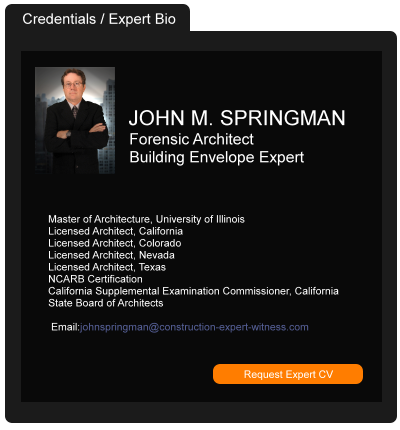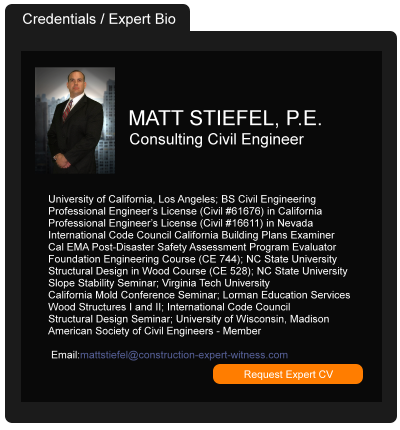Bill Taylor Co-Authors Chapter in Pennsylvania Construction Law Book
October 26, 2017 —
William Taylor - White and Williams LLPBill Taylor, Co-Chair of the Construction and Surety Group, co-authored a chapter in the recently released third edition of Pennsylvania Construction Law: Getting Started, Getting Covered, Getting Paid. The book, published by the Pennsylvania Bar Institute, follows the development of a construction project through contracts, insurance and bonding, performance, claims, warranties and completion, and for troubled projects, termination. Bill's chapter focuses on surety bonds on construction projects in Pennsylvania.
Read the court decisionRead the full story...Reprinted courtesy of
William Taylor, White and Williams LLPMr. Taylor may be contacted at
taylorw@whiteandwilliams.com
Hurricane Laura: Implications for Insurers in Louisiana
October 19, 2020 —
Jennifer Michel & Tabitha Durbin - Lewis BrisboisJust two days before the 15th Anniversary of Hurricane Katrina, Category 4 Hurricane Laura made landfall near Cameron, Louisiana. Although the “unsurvivable” 20-foot storm surge, which had been predicted ahead of the storm, thankfully was significantly less, the impact of Laura on the Southwest Coast of Louisiana and Southeast Coast of Texas and its neighboring parishes and counties, most notably Cameron Parish, was quite severe. Lake Charles, Louisiana suffered widespread flooding and sustained catastrophic wind damage. Although the storm moved quickly, it retained its strength longer than expected such that even areas well inland sustained considerable damage. Preliminary estimates for insured losses from storm surge, flooding, and winds range from $8 to $12 billion for residential and commercial properties. Insurers providing residential or commercial property insurance in Louisiana should keep the following statutory claims handling requirements in mind.
Louisiana Statutory Provisions
Under Louisiana law, an insurer is expected to comply with certain statutory requirements in investigating and handling claims submitted by its insureds and third-party claimants. The majority of these requirements, and the consequences of their violation, are codified by La. R.S. 22:1892, which governs the payment and adjustment of claims, and La. R.S. 22:1973, which delineates an insurer’s duty of good faith. Together, the statutes impose three requirements on insurers: timely initiation of loss adjustment, timely payment of claims, and a duty of good faith and fairness in the adjustment and payment of said claims.
Reprinted courtesy of
Jennifer Michel, Lewis Brisbois and
Tabitha Durbin, Lewis Brisbois
Ms. Michel may be contacted at Jenny.Michel@lewisbrisbois.com
Ms. Durbin may be contacted at Tabitha.Durbin@lewisbrisbois.com
Read the court decisionRead the full story...Reprinted courtesy of
What Makes a Great Lawyer?
February 06, 2019 —
Danielle Carter - Bremer Whyte Brown & O'Meara LLPGood lawyers have mastered and understand the analytical and communication skills taught in law school, but great lawyers build upon this foundation by continuing to develop traits and skills for success. Here are five tips to help good lawyers enhance client outcomes and excel within their profession.
Be Objective
Lawyers cannot be effective advocates unless they are first willing to perceive and analyze problems from all angles. Lawyers must discern strong claims from weak; urgent concerns from long-term; and large issues from small. A lawyer who adopts the tone of an emotionally-charged client risks alienating the court and jury.
Read the court decisionRead the full story...Reprinted courtesy of
Danielle Carter, Bremer Whyte Brown & O'Meara LLPMs. Carter may be contacted at
info@bremerwhyte.com
Revisiting the CMO; Are We Overusing the Mediation Privilege?
November 19, 2021 —
Michael T. Kennedy Jr. - BERDING|WEILOne of the most common features in construction defect cases is the Case Management Order (“CMO”) or Pre-Trial Order (“PTO”) to govern pre-trial and mediation procedures. CMOs and PTOs arose in the days when the HOA would sue the developer, the developer would cross-complaint against the subcontractors, and each defendant and cross-defendant might have 2 or 3 insurance carriers defending, each of whom may retain their own panel counsel. In a large case there may have been 20 parties and 30 defense attorneys. In order to avoid the cost and chaos of all of those parties propounding their own discovery, and in order to prepare these cases for mediation well before trial and the associated costs, it became standard practice in California to include provisions in the CMO to stay all discovery until just before trial.
Plaintiff would provide a Defect List or Statement of Claims and the parties experts would meet and exchange information as part of the mediation process. All of the information exchanged would be subject to mediation privileges and inadmissible at trial. The benefit of this practice was that the parties (and carriers) would avoid the cost of formal discovery and allow the experts to discuss compromised scopes of repair to help settle the case while being able to take a more aggressive position at trial. The disadvantages are that each party uses its privileged initial expert reports to stake out negotiating positions more extreme than what they would put on at trial, with each side losing credibility with the other in assessing the value of the case, and for those cases that did not settle, the parties would be faced with having to do all of the depositions and discovery in the last 60 days, or delaying trial, or both.
Over the last 10 or 15 years with the advent of wrap-up insurance policies, these cases now usually involve 2 sides instead of 20; only the HOA and the developer remain in the case. However, old habits die hard, and the standard CMO/PTO hasn’t evolved with other aspects of these cases. The practice of staying all discovery and exchanging information only under mediation privileges remains, and as a result insurance carriers don’t receive the admissible evidence that they need to determine coverage and evaluate the real settlement value of the case until just before trial. On the plaintiff’s side, if most of the experts’ work is done under the guise of mediation privilege, those costs may not be recoverable. Outside the context of mediation, costs incurred in investigation of the defects and preparation of a scope and cost of repair are recoverable.
This reflexive claim of mediation privilege over all information exchanged during the case has outlived its usefulness. The CMO can and should remain to regulate formal discovery and to help the parties prepare for mediation, but regulated discovery should be opened early in the case. In California, the SB800 process already provides for the exchange of admissible information during the prelitigation right to repair process. Continuing that exchange during the early litigation allows the parties to continue to prepare for mediation, but waiving privileges had advantages for both sides.
A senior claims manager once commented that Plaintiff’s mediation-protected Statement of Claims “might as well be a stack of blank paper” for all of its usefulness to the carrier in assessing the value of the case. If the Plaintiff and it expects are free to inflate their claims early in the case without having to worry about every supporting those claims in front of a jury, they have little or no credibility. And if those claims are inflated or not “real,” not only can the carrier not properly assess the verdict range and settlement value of the case, but it may also be hampered in making a coverage determination. Simply put, if the exchange of real information through formal discovery is put off until just before trial, the defense cannot be ready to settle until then. Worse, the cost of defense goes through the roof in the last 60 days before trial as the lawyers’ scramble to take all of the depositions and to all of the other work that had been stayed for the previous year or two.
The Plaintiff is faced with the same question of credibility of defense experts where they are free to take a “low ball” negotiating position without having to support that position through cross-examination in front of the jury. Just as the carrier behind the defense attorney needs the Plaintiff’s “real” evidence to assess the claim, so does the HIOA Board of Directors behind the Plaintiff’s counsel. Additionally, in California as in most states, the cost of experts’ preparation for mediation may not be recoverable as costs or damages, but investigation of the defects and preparation of the scope and cost of repair is recoverable.
The biggest challenge is resolving construction defect claims for both sides is how to resolve these cases quickly while keeping costs under control. Practices that worked 20 years ago are no longer applicable with changes in insurance, and in light of some of the bad habits that arise when all of the information exchanged was confidential.
The CMO/PTO process can still be useful to regulate the discovery and mediation schedule given the volume of documents and other information to be exchanged but exchanging “real” information in a form that may come into evidence at trial should foster earlier resolution, resulting in cost savings for the parties. The CMO can provide for the parties to respond to controlled discovery, and the exchange of expert reports and potentially depositions can and should be done earlier in the case, well before the eve of trial. The parties can then assess the true value of each case and prepare for more substantive mediation without waiting until they are on the figurative courthouse steps.
Construction defect cases have a pattern, and it is tempting for busy lawyers to just put each case through the same algorithms that they have used for years. However, these cases have evolved and those of us handling these cases need to reevaluate our approach to these cases. Taking aggressive negotiating positions that no longer have any credibility with the other side has become counterproductive, and the exchange of real evidence earlier in the case would better serve our clients and carriers.
BERDING|WEIL is the largest and most experienced construction defect and common interest development law firm in California. For more information, please visit https://www.berding-weil.com
Read the court decisionRead the full story...Reprinted courtesy of
Michael T. Kennedy Jr., BERDING|WEILMr. Kennedy may be contacted at
mkennedy@berdingweil.com
Vacant Property and the Right of Redemption in Pennsylvania
April 06, 2016 —
Suzanne Prybella – White and Williams LLPIn Pennsylvania, pursuant to the Municipal Claims and Tax Liens Act (53 P.S. §7293(a)) (the Act), the owner of a property sold under a tax or municipal claim may redeem the sold property at any time within nine months after the date of acknowledgment of the sheriff's deed by, in general, paying the amount of the debt. However, there is a caveat contained in the Act with respect to vacant property, which states that “there shall be no redemption of vacant property by any person after the date of the acknowledgment of the sheriff's deed.” (53 P.S. §7293(c)). In Brentwood Borough School District v. HSBC Bank USA, N.A., 111 A.3d 807 (Pa. Commw. Ct. 2015), a case of first impression before the Commonwealth Court of Pennsylvania, the court addressed the definition of “vacant property” under the Act and the timing of a petitioner to invoke the right of redemption with respect to vacant property.
Read the court decisionRead the full story...Reprinted courtesy of
Suzanne Prybella, White and Williams LLPMs. Prybella may be contacted at
prybellas@whiteandwilliams.com
Suing the Lowest Bidder on Public Construction Projects
September 17, 2015 —
Craig Martin – Construction Contractor AdvisorThe California Court of Appeals has allowed the second lowest bidders on public construction projects to sue the lowest bidder where it appears that the lowest bidder was only the lowest because it paid its employees less than the established prevailing wage. This is a novel theory for recovery, but may provide for an opportunity to challenge improperly low bids.
Background
Between 2009 and 2012, American Asphalt outbid two asphalt companies on 23 public works projects, totaling nearly $15 million. The two asphalt companies sued American Asphalt alleging that they were the second lowest bidder all 23 construction projects and they would have been the lowest had American Asphalt paid its employees the required prevailing wage. Importantly, the municipality awarding the contracts was not sued by the second lowest bidders. Instead, the second lowest bidders alleged that American Asphalt intentionally interfered with a business expectancy and sought damages from American Asphalt, specifically the profit that they lost by not performing these contracts.
Read the court decisionRead the full story...Reprinted courtesy of
Craig Martin, Lamson, Dugan and Murray, LLPMr. Martin may be contacted at
cmartin@ldmlaw.com
Economy in U.S. Picked Up on Consumer Spending, Construction
October 02, 2015 —
Shobhana Chandra – BloombergThe world’s largest economy expanded more than previously forecast in the second quarter, boosted by gains in consumer spending and construction that may help the U.S. withstand a global slowdown.
Gross domestic product rose at a 3.9 percent annualized rate, compared with a prior estimate of 3.7 percent, Commerce Department figures showed Friday in Washington. The median forecast of 76 economists surveyed by Bloomberg called for a 3.7 percent gain.
Strong hiring, cheaper gasoline and higher home prices will probably sustain household purchases, which account for about 70 percent of the economy. That helps bolster Federal Reserve Chair Janet Yellen’s view that the U.S. will overcome any fallout from cooling overseas markets and swings in global financial and commodity markets.
Read the court decisionRead the full story...Reprinted courtesy of
Shobhana Chandra, Bloomberg
Shimmick Gets Nod for Second Pilot Pile at Settling Millennium Tower
December 13, 2021 —
Nadine M. Post - Engineering News-RecordAfter the successful installation of a 24-in.-dia permanent pilot pile at the troubled foundation upgrade of the settling Millennium Tower in San Francisco, the Dept. of Building Inspection (DBI) has given Shimmick Construction Co. permission to install a second pilot pile, beginning Dec. 1.
Reprinted courtesy of
Nadine M. Post, Engineering News-Record
Ms. Post may be contacted at postn@enr.com
Read the full story... Read the court decisionRead the full story...Reprinted courtesy of


































































